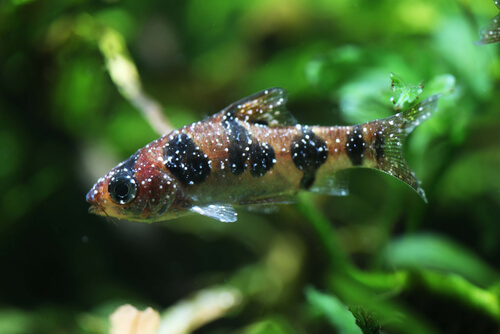Epistylis vs Ich: Transmission, Similarities, Differences, and Treatment
Posted by on 03/02/2023
We use affiliate links and may receive a small commission on purchases.
One of the tougher aspects of fishkeeping is dealing with diseases. They can be easily introduced into an aquarium, and once they take hold, they can be difficult to eradicate. Worst of all, if you don’t take action quickly, harmful parasites and diseases can wreak havoc in a fish tank, resulting in fatal consequences for your tank's inhabitants.
While many diseases can affect freshwater fish, one of the most common is known as Ich. This parasite is well-documented, and there are many natural and manufactured treatment options.
However, a commonly misdiagnosed disease known as Epistylis can also be found in many freshwater aquariums. This disease displays many similar symptoms as Ich but requires different methods of treatment. In this post, we’ll discuss the transmission, similarities, differences, and treatments for these two diseases.
Table of Contents
Ich
Freshwater Ich (scientific name: Ichthyophthirius multifiliis), also referred to as White Spot Disease, is one of the most common diseases in the freshwater aquarium hobby. The disease is the result of a parasite, which is often introduced by an affected fish that may or may not display symptoms.
If left untreated, the disease can be fatal and will spread quickly between aquarium fish.

Epistylis
Epistylis is technically a genus of Ciliates , which are some of the most complex single-celled organisms on our planet. These organisms can be found swimming throughout our Aquarium's water column, and are believed to feed off bacteria and other microorganisms.
Similar to Ich, once a species of Epistylis takes over an aquarium, it can be fatal to all of your tank inhabitants.
Similarities
Both Ich and Epistylis share many similarities. It's common to see cases of Epistylis misdiagnosed as Ich. Many hobbyists are unfamiliar with Epistylis and assume an Epistylis outbreak is freshwater Ich.
🛒 Shop Freshwater Fish on Light Fish
Symptoms
Both Epistylis and Ich can display similar visual symptoms, but there are some subtle differences to look for. Each disease will present itself as small white dots on the body of the affected fish.
Fish may also demonstrate a lack of appetite and become more lethargic.
Fish that are affected by both diseases may exhibit a behavior known as "flashing." This refers to the rapid swimming burst that fish use to launch themselves into an object, which is believed to serve as a form of scratching.
Differences
While both diseases have a similar effect on a fish's behavior, there are subtle visual differences to look for. Additionally, treatment and transmission do vary between these two diseases.
🛒 Shop Aquarium Plants Fish on Light Fish
Appearance
Ich will present itself as flat, equally-sized white dots (known as trophants), while Epistylis may appear as raised white dots, white powder, or fuzzy-looking patches that vary in size .
Epistylis will also appear on the eyeball of a fish, a feature less seen in Ich.
If you believe that your fish are affected by Ich or Epistylis, you'll want to examine the size, distribution, and location of the white spots covering the fish's body.
Transmission
Ich enters an aquarium through an infected fish. It's a host-dependent parasite, and will eventually die off after a few weeks if there are no suitable hosts in an aquarium.
Epistylis already exists in most tanks, as it's found in the majority of water sources. Epistylis lives in the water column but will remain dormant unless there is a bacterial bloom for the species to feed upon.
Treatment
You'll need to employ different treatment methods depending on whether or not you have Ich or Epistylis.
Ich treatment typically involves raising your aquarium temperature to around 83-85°F, and dosing a reputable over-the-counter solution, such as Ich-X .
After treatment, you'll want to perform a 50% water change to remove any remaining parasites. It may take a few rounds of treatment to fully eradicate Ich.
Fortunately for hobbyists with fish affected by Epistylis, treatment is relatively straightforward. Epistylis thrives in warm-water conditions, so you'll want to reduce the overall temperature of your aquarium. Depending on your livestock, this should be about 5-8 degrees cooler than your current average temperature.
Then, you'll want to perform 20-30% water changes every 2-3 days.
In many instances, this will clear up Epistylis over a 2-3 week period. However, if you're still struggling to get this disease under control, you can use medication such as Minocycline .
Dose one capsule of Minocycline for every 20 gallons of water, for 5 days, combined with a daily 25% water change. After treatment ends, you should see symptoms starting to clear up after about 2 weeks.
Prevention Tips
The best form of treatment is always prevention. In many cases, these diseases appear when water conditions are poor. Poor water conditions will weaken a fish's immune system, making them more susceptible to diseases. Maintaining pristine water conditions, by performing weekly 30-40% water changes will keep your fish's immune system in tip-top shape, allowing them to fend off these harmful diseases.
It's also important to only buy from reputable sellers and quarantine any new livestock before placing them into a display tank. Quarantining a fish for 2-3 weeks in an established quarantine tank will allow you to monitor them for signs of diseases before introducing them into your display tank.
Conclusion
As you can see, Epistylis and Ich are diseases that present similar symptoms that often go misdiagnosed. It's important to formulate an accurate diagnosis so that you can follow a treatment plan that's specific to Ich or Epistylis.
Have you successfully treated one of these diseases before? Let us know by commenting below, or head on over to our marketplace and community forum, where you can connect with other like-minded aquarium hobbyists.
December's Giveaways on Light Fish




















